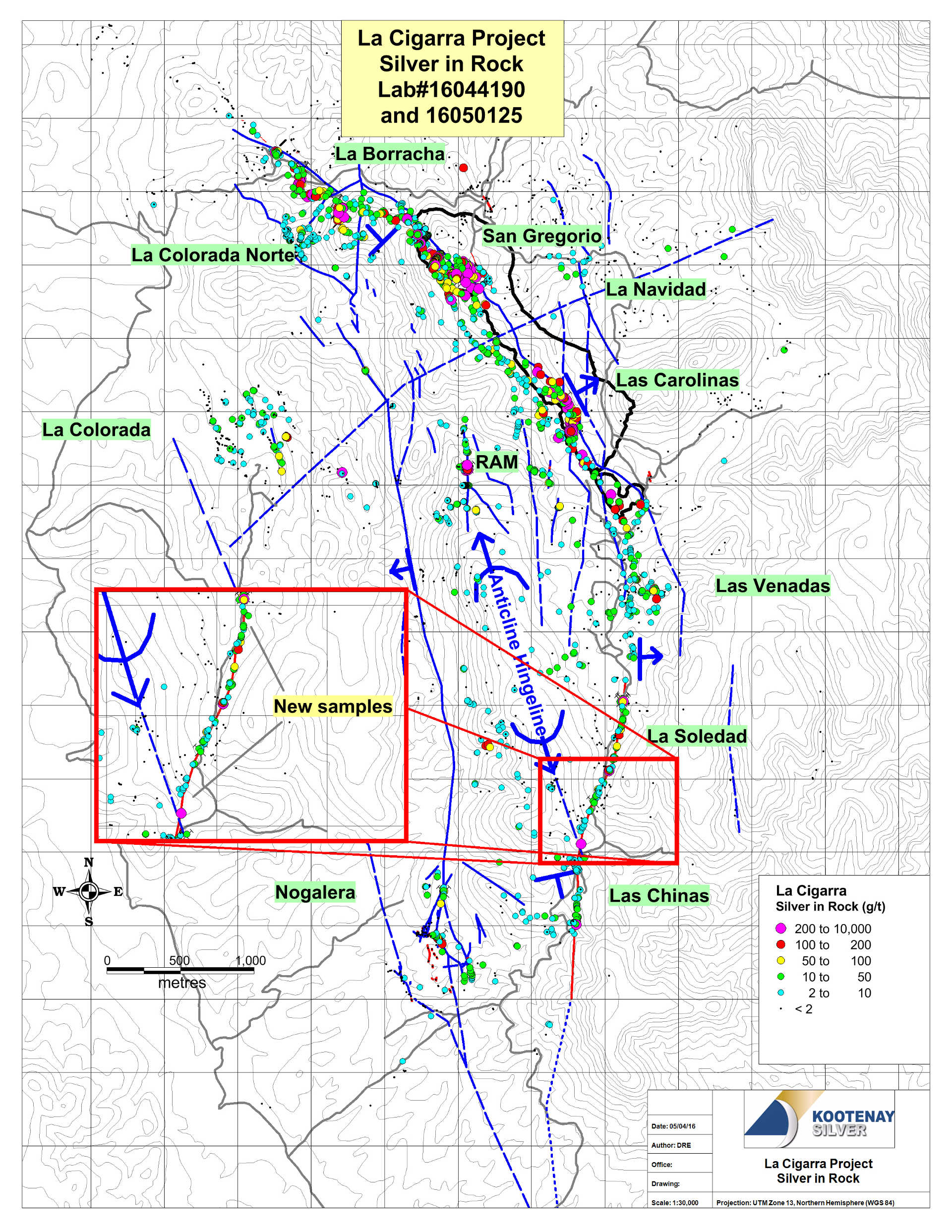La Soledad - historyIt is currently being drilled. It has never been drilled before.
It is 1.0 – 1.5 km long, and likely houses a buried extension of our San Gregorio-Las Carolinas resource deposit. As such, La Soledad is likely in the same silver system as San Gregorio-Las Carolinas. As it turns out, Ram Zone is an entirely new silver system. It will be interesting to see what we find at deeper depth, once we eventually drill, say, at 600 – 1,000m vertical depth. If we find the feeder structures down there, I imagine (it could be possible) that we find 2 separate feeder structures – one for each silver system. Feeder structures can be extremely rich (game changer type rich). These feeder structures were likely responsible for creating La Cigarra mineralized veins by feeding hydrothermal fluids through the fault openings.
The large mine dumps and historic mine workings provide strong evidence that La Soledad was worked over (near-surface), in the past, by small-scale artisanal miners. Artisanal miners can often be excellent pathfinders for mineral discoveries. Clearly, at La Soledad, the artisanals found near-surface mineralization to process.
It looks like the minerals are primarily buried under the quartzite hard rock cover. It is possible that the ore mined (in the past) by the artisanals had seeped through small cracks in the quartzite rock. In March 2013, Northair issued its first comments on La Soledad. Little was known about it, and the other targets outside of the resource area, at the time. Northair mentioned that that samples here only reported moderate silver values - due to the area being covered up. However, it also noted this: ``the scope of the historic mine workings are comparable to those found within the Las Carolinas Zone. Much of the area is covered, but soil sampling has defined a broad lead anomaly, supporting the probability that the mineralized system does underlie the covered area.``
The large mine dump content and mine workings (as we know, Las Carolinas Zone turned out to be rich, and the mine workings at La Soledad is similar to the mine workings at Las Carolinas), coupled with broad (and elevated) lead anomaly in the soil samples, suggested to Northair that mineralization could be buried below the cover (the quartzite rock).
Since March 2013, a lot of additional supporting info have been gathered, such as:
* Studies at Nogalera Zone and Ram Zone – 2 other zones (at La Cigarra) with somewhat similar type quartzite rock covers to La Soledad.
* Airborne geophysical study performed in 2015.
* Additional sampling work at La Soledad released in May 2016. The new sampling programed focused on the southern part of La Soledad. Previous La Soledad sampling work concentrated on the northern part, perhaps.
* Additional eyes and ideas – Fred (CEO that discovered La Cigarra) was in his 70s and retired in August 2014. Angela and her team joined Northair at that point, with new eyes. They advanced the model created by Fred`s team. James and his Kootenay team took over earlier this year, with the merger, and I am sure they are advancing the model even further.
Some of the original La Soledad sampling (prior to the 2015/2016 sampling program) showed:
* 277 g/t silver – dump rock
* 85 g/t silver over 2.1m – channel sample
* 498 g/t silver over .90m (likely channel)
I believe these were from the northern part of La Soledad.
As noted above, Kootenay released new sampling work on the southern part of La Soledad in May 2016. Here is a map with the location of the new La Soledad samples.
Image:

Link, if image doesn`t show up:
https://www.kootenaysilver.com/assets/img/nr/LaCigarraGeochemRockCH16044190CH16050125.jpg
As you can see, there seems to be positive (silver in rock) sample results all along La Soledad. A bit of the mineralized fluids could have seeped out, to the surface area, all along the La Soledad fault structure.
Below is a link to the May 2016 NR. One channel sample returned 252 g/t Ag and 20% lead over 1.2m. Generally, the silver in rock content is decent but modest – as to be expected given that the sample location is above the quartzite rock cover, thus we are likely sampling only seepage material. Plus we are also dealing with surface sample dilution from weather impacts over time (i.e. rain washing away the mineral content). Nevertheless, the elevated lead content is a bit interesting.
At La Negra (completely separate property than La Cigarra), it looks like the lead content is coming in at around .50%. At the San Gregorio-Las Carolinas deposit (La Cigarra), we show .31% lead and zinc combined (.13% lead, 18% zinc). The lead component at La Negra should be quite meaningful. I believe I estimated that the secondary medals at La Negra could equate to about 15% of the primary medal (silver) on a silver equivalent basis. The byproduct medal content at La Negra is primarily driven by the lead.
As a result, it is interesting seeing the elevated lead content in the La Soledad surface rock samples, even though it only (likely) represents seepage. There were 70 samples taken. Here are the top 10 best lead results:
20.00%
8.52%
4.90%
2.29%
1.22%
1.03%
.99%
.95%
.87%
.71%
It is difficult to know if this elevated lead content will translate to below the quartzite rock. If it does then perhaps we can see La Negra type lead byproduct results – i.e. .50% lead. It would be even better if we can get into the .50% to .75% lead content range.
Of note, the lead content in samples at Nogalera are extremely elevated (far more extreme than La Soledad, if I recall correctly). La Soledad is located somewhat close to Nogalera. As such, perhaps the lead content becomes more prominent as we get more south on the property.
May 2016 NR:
https://www.kootenaysilver.com/news/kootenay/2016/kootenay-announces-sampling-results-at-la-soledad-zone-la-cigarra-project-mexico-highlights-include-252-gt-silver-and-20-lead